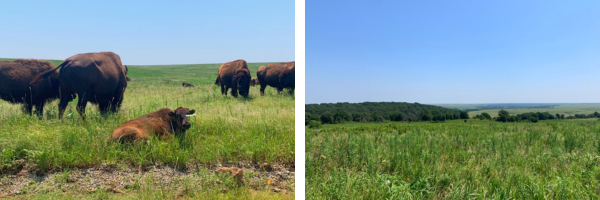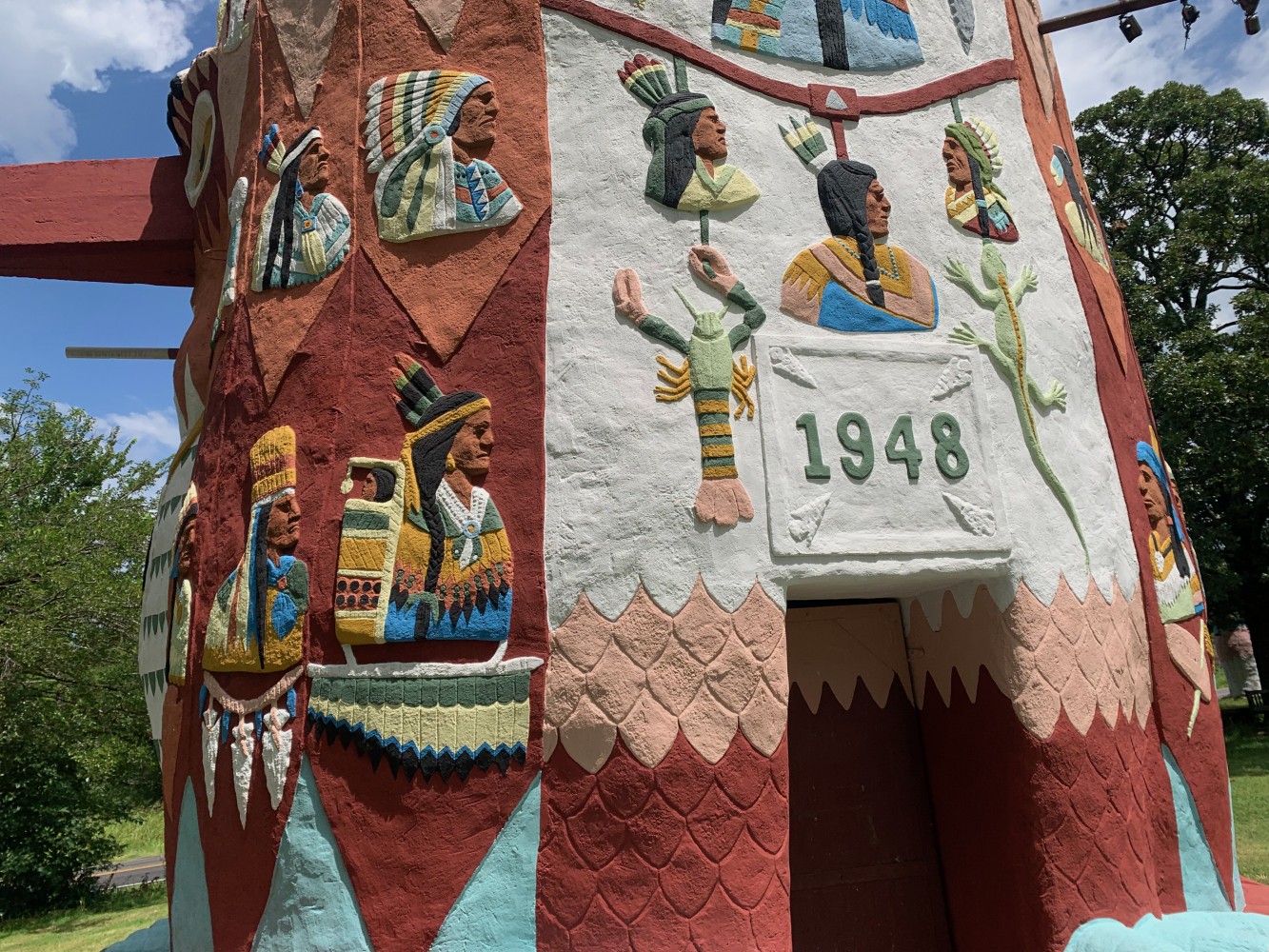This past August, I had the great honor of joining the “Totem as Monument & Archive” workshop and lecture series organized by artist/conservator Erin Turner. This site-specific series was created with the intention to activate the Ed Galloway Totem Pole Park near Claremore, Oklahoma, and examine the art environment through a critical lens addressing issues of Native representation and cultural appropriation.
The first panel, “Totem Pole Parks and Monumentality,” was moderated by Pablo Barrera, Associate Curator at Oklahoma Contemporary, and included: myself (Annalise Flynn, independent curator and manager of SPACES Archives on behalf of Kohler Foundation), Dr. Emily L. Moore, Associate Professor of Art History at Colorado State University and author of Proud Raven, Panting Wolf: Carving Alaska's New Deal Totem Parks; Dr. Russell Cobb, Associate Professor, Graduate Director, Department of Modern Languages and Cultural Studies, University of Alberta and author of The Great Oklahoma Swindle: Race, Religions and Lies in America's Weirdest State; Apollonia Piña, Indigenous activist, organizer for the Matriarch organization, developer of indigenous-centered STEM camp for Native youth, and interdisciplinary researcher of Mvskoke, Xicana, Scots-Irish, and French lineage.
This conversation offered broad contextualization for Ed Galloway’s work – addressing art environments as future monuments, the Civilian Conservation Corps’ creation of Alaska’s Totem Pole Parks, the destruction of tribal property via Oklahoma’s land allotment policy, and the allotment policy’s impact on Native families in Oklahoma. You can watch the panel here.
In addition to deepening my understanding of Ed Galloway’s work and this complex part of the country, participating in this program offered me the extremely exciting opportunity to visit several incredible art environments that had been high on my list for many years. First – The Blue Whale.

The drive from downtown Tulsa to the Totem Pole Park takes you directly past a Route 66 attraction that’s impossible to miss. Created by retired zoologist Hugh S. Davis for the enjoyment of his grandchildren, the Blue Whale had fallen into disrepair after his and his wife Zelta’s passing. The popular attraction was purchased by the City of Catoosa, Oklahoma, in 2020, and is now restored and open to the public.
Next stop – the Ed Galloway Totem Pole Park.
Erin met me and my fellow panelist Emily out at the site for a tour. Erin is originally from Tulsa (a 45-minute drive from the park) and has led site conservation since 2015. Her and her colleagues’ efforts have included completely repainting the majority of the structures with a silicate-based mineral paint – paint that bonds with the concrete substrate rather than just coating the surface like latex, which will eventually fade and peel. It had been several years since the largest sculpture was last painted, and the colors remain vibrant and fresh.
While guiding us through the site, Erin pointed out some of the features that make Galloway’s totems particularly unique, like his references to native Oklahoman wildlife, including the crayfish pictured below.

An important element of Erin’s work is providing historic and cultural context for Galloway’s sculptures. The Totem lecture and workshop series was a critical step toward crafting interpretive materials for the site that educate visitors on the ways Galloway’s artwork does – and does not – connect with Native American practices. For example, these sculptures are not representative of local Indigenous people as there are no totem building traditions in Oklahoma. Members of Galloway’s family visited the Totem parks of Alaska in the 1940s and sent him a postcard from their trip. It’s been posited that this is how he became inspired to create his own totem park – not through a particular understanding of, or partnership with, the Native people in his own community. Future efforts at the site may include opportunities for visitors to connect with actual Native creative practitioners, thereby utilizing Galloway’s cultural appropriation as a platform for the amplification of Native voices.

I took advantage of being in the Great Plains and tacked on a trip to Lucas, Kansas – a major art environment destination. Erin generously provided a custom driving route that took me through some incredibly scenic parts of Oklahoma, including the Tall Grass Prairie outside of Pawhuska.
I knew I was getting close to Lucas when I began seeing the limestone post rock fences corralling the agricultural landscape.

Once I arrived in Lucas (about a 5 hour drive from Tulsa), I met up with Erika Nelson – artist, Cultural Resources Director for S.P. Dinsmoor’s Garden of Eden, and longtime Lucas resident – who gave me a tour of the creatively activated town. Nearly all of the buildings in Lucas’s two-block downtown are used in service of the arts, including Erika’s gallery, The World's Largest Collection of the World's Smallest Versions of the World's Largest Things, and resource center, Woodpecker Archives. The Grassroots Art Center is also downtown and boasts a large collection of work by artists working in every imaginable medium throughout Kansas and the region. Artists have had a hand on almost every surface downtown, including telephone poles, empty lots, and other public amenities like Bowl Plaza, a completely mosaicked restroom with a swirling toilet bowl as entrance. And though the population of Lucas is quite small – less than 500 – the town has its own artist cooperative that sells the work of around 40 artists.
In addition to touring me around town, Erika also shared the in-progress preservation work at Florence Deeble’s Rock Garden. Erika and Matthew Farley have been diligently working on the site since 2021 – cleaning, stabilizing, and preserving Deeble’s depictions of some of the United States most stunning natural (and unnatural) features.


Florence Deeble’s Mount Rushmore
My trip to Lucas culminated in a visit to S.P. Dinsmoor’s Garden of Eden – one of the country’s first art environments (as we understand them now) and the town’s creative foundation. Dinsmoor’s towering concrete sculptures create a sinewy perimeter that tightly hugs the property. Reading Dinsmoor’s tableaux – soldier hunts Native American hunts dog hunts cat, and so forth, for example – against the backdrop of a very blue Kansas sky on a very hot Kansas day was a major highlight of the trip.

There are many more exceptional destinations in the Great Plains, but here’s a map with the places listed above (plus a few bonus hot spots) for your next trip to the region. And please get in touch if you know more sites that should be on our radar!



Post your comment
Comments
No one has commented on this page yet.